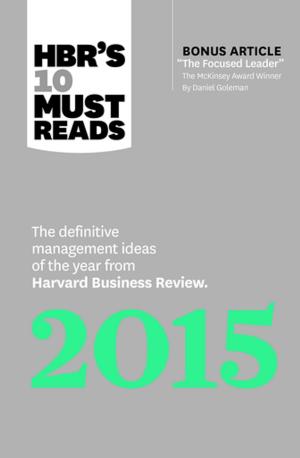The Optimum Manager
Business & Finance, Management & Leadership, Management, Human Resources & Personnel Management| Author: | Glen Andersen | ISBN: | 9781301166862 |
| Publisher: | Glen Andersen | Publication: | March 8, 2013 |
| Imprint: | Smashwords Edition | Language: | English |
| Author: | Glen Andersen |
| ISBN: | 9781301166862 |
| Publisher: | Glen Andersen |
| Publication: | March 8, 2013 |
| Imprint: | Smashwords Edition |
| Language: | English |
All businesses need an efficient and inexpensive strategy for optimally motivating all employees that is easy to implement and adaptable to all personality types. Most importantly, it should address the fundamental reason why employees are unmotivated to begin with; continuously occurring negative unspoken messages that have become institutionalized in our businesses.
We send one such negative unspoken message to our employees when we do not pay them in direct proportion to their productivity. It is commonplace for a more productive employee to make less per unit of output than a less productive employee. According, and without saying a word, the more productive employee is discouraged from increasing his productivity and the less productive employee is encouraged to decrease his productivity. This situation acts as a significant damper to the optimization of employee motivation.
Negative unspoken messages such as the one just described act as a swift current against which all employees must swim. We all want to succeed in our jobs. But these strong currents of negative unspoken messages can discourage even the most motivated employees among us. Unfortunately, we have been swimming against these currents for so long and they are so ingrained in our business environment that we hardly recognize their presence. We accept them as normal business challenges.
Developers of existing employee motivation and productivity strategies have used one of the following three approaches: 1) cede to the presence of the negative unspoken messages and propose workarounds to swim against the current; 2) identify one or more of the negative unspoken messages and propose a radical restructuring of the business to remove them; or, 3) identify successful businesses with motivated employees and create lists of best practices that they attribute to these higher levels of motivation. Based upon results presented by these motivational and productivity strategy developers, none of them have developed a strategy that is capable of optimally motivating all employees in all business environments by effectively removing all negative unspoken messages.
The optimal strategy for employee motivation is one where each and every employee is motivated to perform at their own personal optimum level of productivity. This optimum level will not be the same for all employees, but will be a reflection of their own talents, abilities, wants and needs. The key here is that the optimum level of productivity should be the employee’s own unique decision and not a one size fits all.
In other words, the best way to optimize the productivity of a group of employees is to allow each employee to optimize their own level of productivity as individuals and in an environment where they are able to express their own personal needs and wants independently of others.
The Optimum Manager presents such an optimal strategy for employee motivation and productivity. It stops the negative unspoken messages at their source and places all employees in an environment where they are able to motivate themselves without having to swim against strong and discouraging currents. In this environment, an optimum manager leads by actions, not by words. The increase in level of employee productivity (100% to 200%) observed by the author dwarfs the reported increases in employee productivity boasted by other employee motivational and productivity strategies (50% or less).
The strategy presented in The Optimum Manager is called “Tasks-Completed-Correctly” and it focuses on the process of making and receiving work assignments and measures success when a task has been completed correctly. There is no need to restructure the business environment; only to make a small but very significant change to the manner in which work assignments are given and in which performance is measured and rewarded.
All businesses need an efficient and inexpensive strategy for optimally motivating all employees that is easy to implement and adaptable to all personality types. Most importantly, it should address the fundamental reason why employees are unmotivated to begin with; continuously occurring negative unspoken messages that have become institutionalized in our businesses.
We send one such negative unspoken message to our employees when we do not pay them in direct proportion to their productivity. It is commonplace for a more productive employee to make less per unit of output than a less productive employee. According, and without saying a word, the more productive employee is discouraged from increasing his productivity and the less productive employee is encouraged to decrease his productivity. This situation acts as a significant damper to the optimization of employee motivation.
Negative unspoken messages such as the one just described act as a swift current against which all employees must swim. We all want to succeed in our jobs. But these strong currents of negative unspoken messages can discourage even the most motivated employees among us. Unfortunately, we have been swimming against these currents for so long and they are so ingrained in our business environment that we hardly recognize their presence. We accept them as normal business challenges.
Developers of existing employee motivation and productivity strategies have used one of the following three approaches: 1) cede to the presence of the negative unspoken messages and propose workarounds to swim against the current; 2) identify one or more of the negative unspoken messages and propose a radical restructuring of the business to remove them; or, 3) identify successful businesses with motivated employees and create lists of best practices that they attribute to these higher levels of motivation. Based upon results presented by these motivational and productivity strategy developers, none of them have developed a strategy that is capable of optimally motivating all employees in all business environments by effectively removing all negative unspoken messages.
The optimal strategy for employee motivation is one where each and every employee is motivated to perform at their own personal optimum level of productivity. This optimum level will not be the same for all employees, but will be a reflection of their own talents, abilities, wants and needs. The key here is that the optimum level of productivity should be the employee’s own unique decision and not a one size fits all.
In other words, the best way to optimize the productivity of a group of employees is to allow each employee to optimize their own level of productivity as individuals and in an environment where they are able to express their own personal needs and wants independently of others.
The Optimum Manager presents such an optimal strategy for employee motivation and productivity. It stops the negative unspoken messages at their source and places all employees in an environment where they are able to motivate themselves without having to swim against strong and discouraging currents. In this environment, an optimum manager leads by actions, not by words. The increase in level of employee productivity (100% to 200%) observed by the author dwarfs the reported increases in employee productivity boasted by other employee motivational and productivity strategies (50% or less).
The strategy presented in The Optimum Manager is called “Tasks-Completed-Correctly” and it focuses on the process of making and receiving work assignments and measures success when a task has been completed correctly. There is no need to restructure the business environment; only to make a small but very significant change to the manner in which work assignments are given and in which performance is measured and rewarded.















